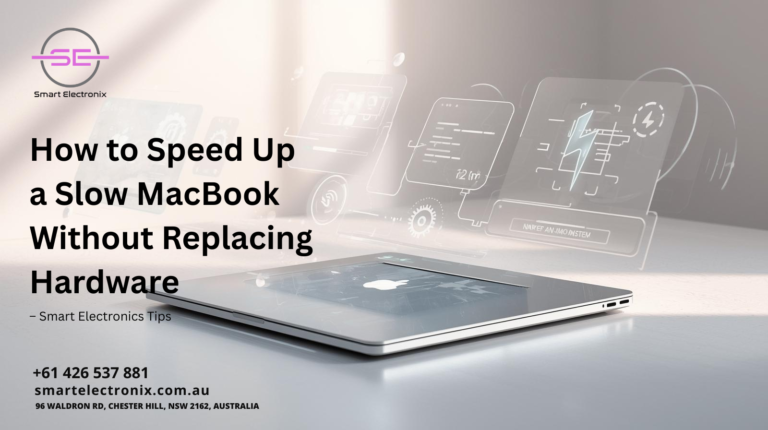
We’ve all experienced the frustration of a slow MacBook. Whether it’s taking forever to boot up, lagging while multitasking, or struggling with everyday apps, a sluggish system can disrupt your productivity. At Smart Electronics, we know how important it is to keep your Mac running smoothly without spending a fortune on hardware upgrades. In this guide, we’ll show you effective ways to speed up a slow MacBook without replacing any hardware.
Identify the Causes of a Slow MacBook
Before diving into solutions, it’s essential to understand why your MacBook is slow. Common causes include:
- Cluttered Storage: Full hard drives can dramatically reduce performance.
- Background Processes: Too many apps running simultaneously can eat up system resources.
- Outdated Software: Old macOS versions may have inefficiencies and bugs.
- Startup Programs: Apps launching at startup can slow down boot times.
- Browser Overload: Multiple open tabs and extensions can impact overall speed.
- Cache and Temporary Files: Accumulated files take up memory and slow processing.
Identifying these issues helps you apply the right strategies to restore your MacBook’s speed.
Step 1: Clean Up Storage
A full hard drive can make any MacBook sluggish. Start by:
- Removing Unused Apps: Delete applications you rarely use.
- Clearing Downloads and Desktop Files: These folders often accumulate unnecessary files.
- Emptying Trash: Don’t forget to permanently delete files from the trash.
- Managing Large Files: Use the built-in Storage Management tool to identify and remove large files.
Keeping at least 20% of free storage ensures your MacBook runs efficiently.
Step 2: Optimize Startup Items
Many apps launch automatically when you start your MacBook, slowing down boot time. To manage startup items:
- Go to System Preferences > Users & Groups.
- Select your username and click Login Items.
- Remove unnecessary apps from the list.
This simple step can significantly improve startup speed.
Step 3: Close Resource-Hogging Apps
Some applications consume excessive RAM and CPU. Open Activity Monitor to check which apps are draining resources. Quit or restart apps that are using too much memory. Browser tabs, music players, and video editing software are common culprits.
Step 4: Update macOS and Apps
 Running outdated software can cause performance issues. To update macOS:
Running outdated software can cause performance issues. To update macOS:
- Go to System Settings > Software Update.
- Install any available updates.
Also, keep your apps updated through the App Store or directly from the developer. Updated software often includes performance improvements and bug fixes.
Step 5: Clear Cache and Temporary Files
Cache files speed up processes temporarily, but excessive accumulation can slow down your Mac. Clear cache by:
- Opening Finder > Go > Go to Folder.
- Type
~/Library/Cachesand delete unnecessary files. - Repeat for
/Library/Caches.
Additionally, clear browser cache to enhance browsing performance.
Step 6: Reduce Visual Effects
MacOS offers visual effects that look great but can use significant system resources. To reduce them:
- Go to System Preferences > Accessibility > Display.
- Enable Reduce motion and Reduce transparency.
This frees up resources for essential tasks, improving responsiveness.
Step 7: Manage Browser Performance
Browsers are often the biggest contributors to slow performance. Tips include:
- Limit open tabs.
- Disable or remove unnecessary extensions.
- Use lightweight browsers for specific tasks.
- Clear browsing data regularly.
These steps can significantly improve overall MacBook speed.
Step 8: Reset SMC and PRAM/NVRAM
Sometimes, system settings affect performance. Resetting SMC (System Management Controller) and PRAM/NVRAM can help:
- SMC Reset: Turn off Mac, hold Shift + Control + Option + Power for 10 seconds, then restart.
- PRAM/NVRAM Reset: Restart Mac and hold Option + Command + P + R for 20 seconds.
These resets often resolve issues with battery management, fan speed, and display settings.
Step 9: Optimize Storage with Smart Electronics Tools
Smart Electronics recommends using trusted optimization tools like CleanMyMac X or OnyX. These apps can safely remove junk files, manage startup items, and optimize system performance without manual intervention.
Step 10: Regular Maintenance Habits

- Restart your MacBook at least once a week.
- Avoid running multiple heavy apps simultaneously.
- Regularly check for software updates.
- Monitor storage and clean unnecessary files periodically.
Consistent maintenance prevents slowdowns and extends the lifespan of your MacBook.
Conclusion
A slow MacBook doesn’t always mean it’s time to upgrade hardware. With proper maintenance, cleaning, software updates, and smart optimization techniques, you can significantly boost performance. At Smart Electronics, we emphasize practical solutions that save time and money while enhancing productivity.
By following these steps, your MacBook will feel faster, more responsive, and ready to handle daily tasks efficiently. Keep your system optimized, and enjoy a smoother computing experience without spending a dime on new hardware.
